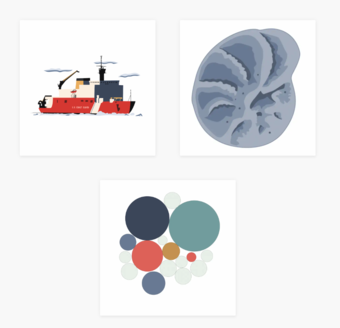Beaufort Sea Data Visualizations
December 19, 2024
Media


Sources/Usage: Public Domain. View Media Details
The Arctic Ocean is undergoing dramatic sea ice reduction and warming conditions. The researchers of this project use microfossils from sediment cores taken in the Beaufort Sea to rebuild the climate patterns, sea ice and circulation, and ecosystems from the past 2000 years. Three interactive data visualizations help tell this story:
- Beaufort Sea sediment coring
- Beaufort Sea microorganism species
- Beaufort Sea timeline
The Beaufort Sea data visualizations are part of the Earth in Flux chart gallery, which is a shared initiative between the USGS Water Mission Area and Ecosystems Mission Area to communicate key findings of USGS land change science in innovative ways, and to encourage creativity, exploration, and community in data visualization across USGS mission areas.
Related
Water Data Visualizations
Water data visualizations are provocative visuals and captivating stories that inform, inspire, and empower people to address our Nation's most pressing water issues. USGS data science and visualization experts use visualizations to communicate water data in compelling and often interactive ways when static images or written narrative can’t effectively communicate the interconnectivity and...
Land-Sea Linkages in the Arctic
The Arctic is undergoing historically unprecedented changes in weather, sea ice, temperature and ecosystems. These changes have led to greater coastal erosion, greater export of freshwater, and changes to marine and terrestrial ecosystems, habitats, and productivity, among other trends. Meanwhile, many believe the Arctic “amplifies” large climate changes during both warm periods and ice ages and...
Data Release to Multi-proxy record of ocean-climate variability during the last 2 millennia on the Mackenzie Shelf, Beaufort Sea (2013)
A 2,000 year-long oceanographic history of a Canadian Beaufort Sea continental shelf site (60-meters water depth) near the Mackenzie River outlet is reconstructed from various proxies: ostracode faunal assemblages, shell stable isotope ratios (δ18O, δ13C) and sediment biogenic silica. These proxies are extracted from three sediment cores that made a composite section, HLY1302 JPC32...
Multi-proxy record of ocean-climate variability during the last 2 millennia on the Mackenzie Shelf, Beaufort Sea
A 2,000 year-long oceanographic history, in sub-centennial resolution, from a Canadian Beaufort Sea continental shelf site (60meters water depth) near the Mackenzie River outlet is reconstructed from ostracode and foraminifera faunal assemblages, shell stable isotopes (delta 18O, delta 13C) and sediment biogenic silica. The chronology of three sediment cores making up the composite...
Authors
Laura Gemery, Thomas M. Cronin, Lee W. Cooper, Lucy Roberts, Lloyd D. Keigwin, Jason A. Addison, Melanie Leng, Peigen Lin, Cedric Magen, Marci E. Marot, Valerie Evelyn Schwartz
Late Holocene paleoceanography in the Chukchi and Beaufort Seas, Arctic Ocean, based on benthic foraminifera and ostracodes
Calcareous microfossil assemblages in late Holocene sediments from the western Arctic continental shelf provide an important baseline for evaluating the impacts of today’s changing Arctic oceanography. This study compares 14C-dated late Holocene microfaunal assemblages of sediment cores SWERUS-L2-2-PC1, 2-MC4 and 2-KL1 (57 mwd), which record the last 4200 years in the Herald Canyon...
Authors
Julia Lynn Seidenstein, Thomas M. Cronin, Laura Gemery, Lloyd D. Keigwin, Christof Pearce, Martin Jakobsson, Helen K Coxall, Emily A. Wei, Neal W. Driscoll
Related
Water Data Visualizations
Water data visualizations are provocative visuals and captivating stories that inform, inspire, and empower people to address our Nation's most pressing water issues. USGS data science and visualization experts use visualizations to communicate water data in compelling and often interactive ways when static images or written narrative can’t effectively communicate the interconnectivity and...
Land-Sea Linkages in the Arctic
The Arctic is undergoing historically unprecedented changes in weather, sea ice, temperature and ecosystems. These changes have led to greater coastal erosion, greater export of freshwater, and changes to marine and terrestrial ecosystems, habitats, and productivity, among other trends. Meanwhile, many believe the Arctic “amplifies” large climate changes during both warm periods and ice ages and...
Data Release to Multi-proxy record of ocean-climate variability during the last 2 millennia on the Mackenzie Shelf, Beaufort Sea (2013)
A 2,000 year-long oceanographic history of a Canadian Beaufort Sea continental shelf site (60-meters water depth) near the Mackenzie River outlet is reconstructed from various proxies: ostracode faunal assemblages, shell stable isotope ratios (δ18O, δ13C) and sediment biogenic silica. These proxies are extracted from three sediment cores that made a composite section, HLY1302 JPC32...
Multi-proxy record of ocean-climate variability during the last 2 millennia on the Mackenzie Shelf, Beaufort Sea
A 2,000 year-long oceanographic history, in sub-centennial resolution, from a Canadian Beaufort Sea continental shelf site (60meters water depth) near the Mackenzie River outlet is reconstructed from ostracode and foraminifera faunal assemblages, shell stable isotopes (delta 18O, delta 13C) and sediment biogenic silica. The chronology of three sediment cores making up the composite...
Authors
Laura Gemery, Thomas M. Cronin, Lee W. Cooper, Lucy Roberts, Lloyd D. Keigwin, Jason A. Addison, Melanie Leng, Peigen Lin, Cedric Magen, Marci E. Marot, Valerie Evelyn Schwartz
Late Holocene paleoceanography in the Chukchi and Beaufort Seas, Arctic Ocean, based on benthic foraminifera and ostracodes
Calcareous microfossil assemblages in late Holocene sediments from the western Arctic continental shelf provide an important baseline for evaluating the impacts of today’s changing Arctic oceanography. This study compares 14C-dated late Holocene microfaunal assemblages of sediment cores SWERUS-L2-2-PC1, 2-MC4 and 2-KL1 (57 mwd), which record the last 4200 years in the Herald Canyon...
Authors
Julia Lynn Seidenstein, Thomas M. Cronin, Laura Gemery, Lloyd D. Keigwin, Christof Pearce, Martin Jakobsson, Helen K Coxall, Emily A. Wei, Neal W. Driscoll



